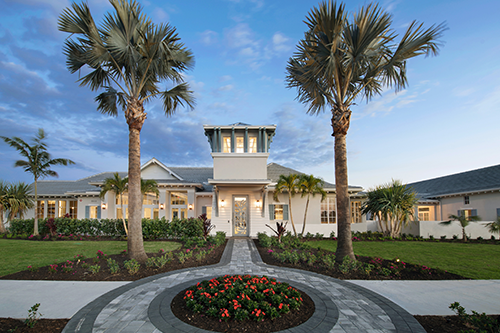

We seem to hear that every year. Whether we're talking about getting fit, saving money, eating better or whatever happens to be trending, “Now, it's more important than ever.”
Given the way society evolves, every time we've heard it, it may well have been true. But one thing is definitely true: the times we're living in right now have been more dynamic than anything we've ever experienced before. In our last white paper, “There's No Place Like Home or Is There?,” we illustrated how pandemic-related influences are particularly changing the meaning of home.
“How people react to these times is as individual as fingerprints.”
-MARY COOK
BREAKING IT DOWN
Demographics vs. Psychographics
In the mid 1960's demographics were seen as the crystal ball that would guide marketing strategies. It was a much simpler time. Essentially, there were two demographic groups: The Greatest Generation and The Baby Boom Generation. And it couldn't have been easier to tell them apart.
Then, in 1964, social scientist Daniel Yankelovich determined traditional demographic traits lacked the insights marketers needed to develop effective strategies. He suggested using non-demographic segmentation to help companies better predict consumer behavior and inform their marketing decisions.
Around that same time, market researcher Emanuel Demby began using the term “psychographics” to describe the consumers' values, opinions, attitudes, interests, lifestyles, aspirations and other relevant psychological characteristics of a specific demographic segment.
“If demographics are 'who they are,'
psychographics are 'what's motivating who they are..”
“Unlike demographics, psychographics are qualitative rather than quantitative. They provide deep insight that complements what we learn from demographics,” the Harvard Business Review (HBR) explains.1
Today, generational identities are more complicated. Boomers, Generation X, Millennials and Generation Z each have varied wants, needs and beliefs that can intersect. Figuring them out and correlating design implications for each can be like untangling coat hangers.
B. 1946 – 1964
The Baby Boomers
WHO
- 57-75 years old
- Wealthy
- Healthy but aging
- Active and fit
- Family and community focused
- Responsible, dependable
VALUES
- Quality time with family and friends
- Proximity to kids and grandkids
- Lock and leave lifestyle
- Unique experiences
- Name brands they know and trust
WANTS
- Single story living
- Space for hosting holiday gatherings
- Quality finishes and fixtures
- Maintenance free homes
- Wired
- Safe and secure community
- Club/resort style amenities
- Programming that fosters community
Who They Are
Baby Boomers are the wealthiest, most active, physically fit generation and currently control over 53% of the country's wealth according to the Fed's data.2 Mostly done accumulating, this generation is taking advantage of travel, leisure, and entertainment activities that provide rich and unique experiences.
What They Value
Boomers must belong, not just be. Family connections, a sense of community and hit the mark for building relationships rank high on their priorities. Self-disciplined and responsible, stability and social order are baked into their DNA along with a desire for safety, and security.
What they want — designing for Boomers
As Boomers age, they prefer single-story, Incorporating stairway-free homes. They still want enough for their cars and room for their children and grandchildren to visit, and to host holiday gatherings. And they're willing to spend the same, or more, for a new home that they did for their last one. They prefer high quality finishes and name brand appliances they can trust. Contrary to popular belief, they're tech savvy, too. Remember, Bill Gates and Steve Jobs were born during the Baby Boom. So, a well-connected, well-wired home is vitally important to them.
“Interestingly, however, when their 'nest' becomes empty, they don't want to move to a smaller one.”
Incorporating maintenance-free exteriors, dedicated parking spaces for their cars and golf carts, and HOAs that take care of lawns, snow removal, and security while they are away and a lock and leave active lifestyle. Gated entries that are staffed or have keypad entry are just the beginning as home security systems grow in importance.
Innovatively themed amenities and social spaces that are experiential like a Wine Tasting Parlor, Whiskey/Bourbon Lounge, Piano Bar or Speakeasy hit the mark for Boomers' desire for enjoying a sense of community in unique ways. Keep in mind they're more likely to arrange an activity beforehand and prefer dedicated spaces for men's and women's activities like cards. Indoor/outdoor spaces on patios, rooftops and courtyards, as well as thoughtfully executed fitness and exercise areas that can accommodate aging, like pickle ball vs tennis, provide additional venues for making connections.
B. 1965 – 1980
Generation X
WHO
- 41-56 years old
- Independent
- Individualistic
- Self-sufficient and resourceful
- Well educated
- At peak earning years
- Technologically adept
- Informal, flexible
- Simultaneously raising children and caring for aging parents
VALUES
- Function over frills
- Caring for family
- Work life balance
- Freedom and responsibility
- Quality lifestyle and neighborhood
WANTS
- Sophisticated style and aesthetics
- Multi-generational friendly homes
- Single family detached
- Suburban
- 3 or 4 bedrooms in 2300+ sq. ft.
- Maintenance free options
Who They Are
Gen Xers are often referred to as “The Baby Busters” or the “Sandwich Generation” because they're wedged between two generations, taking care of aging parents and raising their children at the same time. Gen X saw more women enter the workforce and pursue careers, so couples could likely both be professionals. They're educated, hardworking, leaders. Gen Xers have founded major corporations including Google and Amazon.
They're typically ethnically diverse and value authenticity.
What They Value
As the first generation of “latch key kids” become adults, they are pragmatic, resourceful, and prefer to solve problems on their own. They value function over frills and expect a sophisticated approach to style and aesthetics.
Gen Xers highly value a multi-generational home, which now accounts for about 20 percent of all American households. And it's showing no signs of slowing down.3 With soaring housing prices, aging parents and the changing ethnic makeup of the nation, the trend of multi-generational living is here to stay.
What they want — designing for Gen Xers
Currently in their peak earning years, Gen Xers are looking for a sophisticated upscale aesthetic, high quality appliances and finishes, and floor plan customizations that meet their lifestyle needs. With the high likelihood that their home will begin as, or evolve into a multi-generational home, floorplans need to provide privacy, flexibility, and adaptability so everyone can sleep, relax and work.
Since activities themselves can't take place without spaces that shield family members who may be doing something else, astute space planning must afford families a variety of zones. That means having common areas where family members and their friends can gather, and spaces that are quiet, well-lit and shielded from the hustle and bustle of a busy household. In addition to interior areas, separate entrances, and even small, secluded patios attached to living quarters provide many options.
Lighting, sound, HVAC and security systems should be easy to operate and accessible for members of every generation, whether they choose to use them manually or via remote-controlled apps. Tech-heavy areas in a home should be designed so systems can be updated easily.
All design elements should meet universal design standards so they’re useful for every generation. The National Institute of Building Sciences “Whole Building Design Guide” calls this Flexible Design (loose fit, long life), a principle that anticipates change and the adaptations needed for new systems or changing lifestyles.4
Practicality doesn't have to sacrifice beauty though. Concepts of beauty and living well are gaining traction with multi-generational designs.5 Our Living Better by DesignSM approach ensures multiple generations live together gracefully.
Every inch matters in a multi-generational home. Accommodating in-laws, boomerang children, caregivers, companions, and extended family present distinct considerations. But with intentional planning strategies focused on the needs of each generation, highly functional multi-generational homes can be enjoyed by all.
B. 1981 – 1996
Millennials
WHO
- 25-40 years old
- Internet natives
- 8o million strong
- Workforce majority
- Diverse
- Debt burdened
- Liberal
- Confident, ambitious, impatient, individualistic
- Sheltered by parents, risk adverse
VALUES
- Social share worthiness, likes
- A great deal
- Social responsibility and purpose
- Environmentalism and sustainability
- Meaningful motivation
WANTS
- Fully connected homes
- More space
- Tasteful design
- Sustainable, earth friendly building materials
- New construction
- Communities that foster a great lifestyle
- Upscale unique amenities
Who They Are
Millennials, also known as Generation Y, are on track to make up 75% of the workforce by 2030. Yet, they controlled just 4.6% of U.S. wealth through the first half of 2020.6 They're the first generation of Internet Digital Natives and are the most diverse. Individualistic and self-expressive, especially on social media, they try to stand out and prove themselves. For this generation, it's “Insta or it didn't happen.”
They're constantly coming up with new ideas and making them happen. Known to be impatient, Millennials will usually take the path of least resistance. Challenged with increasing cost of living, student debt and the pandemic, they're more cautious and informed about money matters. They spent 10 years working and living with their parents so they could save up enough for a down payment on a home or apartment.
What They Value
And things are looking up for Millennials. Between the increase in the stock market and home values, they're increasing their wealth. Couples are even higher earners as both are likely to be college educated. According to the National Association of Realtors, Millennials have been the largest share of buyers since their 2014 report. The most recent data shows that 82% of younger millennials and 48% of older millennials were first-time homebuyers, more than other age groups.7
Millennials like a good sale and will comparison shop until they find the biggest bang for their buck on what they want most: modern home technology, and a location that fits their lifestyle.
What they want — designing for Millennials
So, what do Millennials want in a home? Ideally it'd be loaded with the newest technology, entirely integrated and wirelessly connected including prewiring in anticipation of future technology. But more than a digitally equipped home, they want a digital home buying experience with virtual tours that display options. It's surprising to note that nearly 80% could be persuaded to buy a home sight unseen according to a recent survey by St. Louis-based Clever Real Estate.8
“Millennials are driving the green revolution in housing.”
Size matters too. While as renters, they preferred smaller spaces, Millennials buying homes think big. According to the same Clever Real Estate report, they want homes that are 2,400 square feet, compared with 1,700 square feet last year.
Predictably, they value designs that reflect their individual tastes. Smart, versatile spaces should nurture private and communal activities, have quality fixtures and low maintenance finishes, and be neutral enough to accommodate a range of decorative style.
Floor plans should be open, with plentiful and innovative storage that keeps mess and clutter out of sight. At the same time, open space should be dividable for flexibility, functionality and adaptability, They don't just want a place to park their bike, they want a place to repair it. Pet friendly amenities like grooming areas and fenced bark parks are also important to them.
Outdoor entertaining areas including grills, pizza ovens, and fireplaces are important to them. Retractable walls that open to the outside, bring in fresh air and extend living spaces into the outdoors are another sought-after feature.
For couples, the likelihood is high that both are working full time. So, separate, fully equipped offices are critical. They should include privacy solutions to keep sound from trespassing between rooms and disturbing quiet work time. Even powder room placement should take sightlines and sound into consideration.
And, last, but certainly not least, they want their homes, and their communities to be sustainable.
B. 1997 – 2012/15
Generation Z
WHO
- 6-24 years old
- Entrepreneurial, independent, future focused
- Idealistic dreamers but pragmatic
- Determined, passionate and open-minded
- Not over sharers
- Genderless in dress and sports
- Smartphone natives
- Concerned about getting ahead, school, and finances
VALUES
- Individualization
- Being authentic and true to themselves
- People, brands and products that are honest and transparent
WANTS
- Human interaction
- Instant access
- Efficiency
- Openness and collaboration
Who They Are
Our second generation of Digital Natives, Gen Zers are often referred to as the “True” generation. Growing up on smart phones with less helicopter parenting than previous generations, they're tech savvy in a self-disciplined way. They search for truth, value individual expression and avoid labels. They're ethnically diverse like the Millennials before them, and they're on track to be the most educated generation ever.
Gen Zers are multitaskers. If a website isn't connected to social media platforms, it's likely you'll miss reaching them. You can never be too “social media” with this generation. They have little patience for things that don't grab their attention immediately. They'll jump from brand to brand, so you need to stay on your toes! It's imperative to stay current on trends and social media platforms.
It's also important to factor older family members into the equation. They're likely to be the ones making financial decisions for Gen Z and teens.
What They Value
Gen Zers are far less self-centered than Millennials, but we aren't sure how that will translate to housing. Given that they are now the largest U.S. demographic group with 27 percent of the population, we need to pay close attention.9
Millennials like a good sale and will comparison shop until they find the biggest bang for their buck on what they want most: modern home technology, and a location that fits their lifestyle.
What they want — designing for Gen Zers
“They're just starting to explore their options, but we already know they're very different.”
COVID-19 has reshaped the country's social political, and economic landscape. As a result, instead of looking ahead to a world of opportunities, Gen Z now peers into an uncertain future. According to the Pew Research Center, 50% of Gen Zers had someone in their family lose a job or take a pay cut because of the outbreak.10 This generation has been particularly vulnerable because they held many of the service sector jobs that were lost.
Their characteristics and habits are still forming, but so far, in our work designing student housing for them, such as our work at Arizona State University (ASU) where we're designing an upscale 856-bed, luxury, off-campus student housing development called “CANVAS,” we've seen a self-reliant, innovative, and goal-oriented generation.
They need to be marketed to in unique ways and over multiple platforms. At ASU we factored in their penchant for social connection and assisted the marketing team by designing an interactive Instagram Moment in the leasing office. It quickly drove referrals and social media shares.
GEOGRAPHY
A Curve Ball
Psychographic insights about generational preferences on health, wellness and sustainability have also influenced our designs for communal spaces, amenities and model homes nationwide. Interestingly, we've also found that wants and needs vary geographically but intersect generationally.
Understanding how popular preferences are in certain areas of the country has helped us make critical decisions about how to allocate and outfit space. These insights have also been instrumental in formulating the philosophical underpinnings for entire developments.
A developer with offices in Los Angeles and Seattle noted how a single target can vary widely. In upscale homes in LA, primary suites include vanities as large as 14 feet. The same target in Seattle eschews makeup and needs a place to store skis and outdoor equipment.

DO PSYCHOGRAPHIC INSIGHTS WORK?
Since all housing has some degree of crossover appeal, the most basic question for builders and developers becomes: what's the most profitable building to put on a parcel of land? This conundrum is exacerbated by today's high-stakes environment, where labor and material costs impact profitability, and absorption rates don't always go as expected.
While demographics are invaluable in determining the feasibility of a site, psychographic data helps differentiate between a good location and a great one. More than just attitudes and interests, they also shed light on resident's values and lifestyles.
Once again, geography plays an important role. Residents' values and lifestyles are largely influenced by where they're from, family background, culture. Another major factor is education, but the type of education is more a factor than their level of education.
These qualities dictate where and how people will live, what they need in their residences and how we can design spaces that are both transmutable and transformative. The latter is critical because communal and shared spaces must appeal to many, and at the same time be flexible and multi-functional enough to accommodate the needs of residents that have similar lifestyle needs and values but different proclivities.
It's vital to match properties to their most likely target—and the targets it intersects with—long before a project breaks ground. Can psychographic data work for real estate? While it arose out of the consumer products industry, it's “intimately tied to real estate value,” says Mark Stapp, executive director of the master of real estate development program at Arizona State University.11
Customers who buy consumer products are the same people who buy homes and rent apartments. They don't become different people when they look at real estate.
As commercial interior designers that specialize in housing development, we've designed every type of residence from micro-apartments and co-living spaces to green homes and wellness communities. and we've done it all across the country. What's more, we see generational housing decisions becoming more diverse than ever, which further complicates the development process.
With the help of psychographics, community designs are becoming more differentiated today, focusing on wellness, active life, sustainability and more. They also have to appeal to several generations at the same time to foster diversity and inclusiveness. But delivering good design is also paramount.
Psychographics are not a panacea. But if you know how to interpret them, they are the closest thing we have to the proverbial crystal ball.
GET THE PDF VERSION HERE

MEET THE AUTHOR
Mary Cook, Founder and President
Mary Cook is the founder and president of Mary Cook Associates (MCA), a fully integrated interior architecture and design firm nationally known for creating innovative interiors that are targeted to market demands, designed to increase property value and deliver measurable returns. The firm's projects for premier owners and developers of real estate include multi-family, model homes, student living, senior living, clubhouses, restaurants, and hospitality environments. Under Mary's leadership, the work MCA produces emphasizes functionality, showcases possibilities, and accelerates sales and leasing. Currently celebrating its 35th anniversary, the firm continues its national presence with award-winning work that spans 36 states.
Keep an eye out for our next white
paper which explores how investments
in functionality and livability underpin
high-impact designs.

1 “Psychographics Are Just as Important for Marketers as Demographics,” Alexandra Samuel, Harvard Business Review, March 11, 2016, https://hbr.org/2016/03/psychographics-are-just-as-important-for-marketers-as-demographics
2 “Millennials own less than 5% of all U.S. wealth,” Alica Adamczyk, CNBC, October 9. 2020, https://www.cnbc.com/2020/10/09/millennials-own-less-than-5percent-of-all-us-wealth.html
3 “Larger Houses at Forefront as Gen X Shares Housing With Seniors,” National Association of Realtors®, March 17, 2021, https://magazine.realtor/daily-news/2021/03/17/larger-houses-at-forefront-as-gen-x-shares-housing-with-seniors
4 “Whole Building Design Guide,” Don Prowler, WBDG, https://www.wbdg.org/about-wbdg-whole-building-design-guide
5 “Accessible design is growing. But can it be beautiful?,” Maile Pingel, March 30, 2020, The Washington Post, https://www.washingtonpost.com/magazine/2020/03/30/accessible-design-is-growing-can-it-be-beautiful/
6 “Millennials dominate the US workforce, but they’re still 10 times poorer than boomers,” Hillary Hoffower, October 12, 2020, Business Insider, https://www.businessinsider.com/millennials-versus-boomers-wealth-gap-2020-10
7 “Millennials Dominate Buying Market, Generation Z Now Active Buyers, Says NAR Report,” March 16, 2021, National Association of Realtors, https://www.nar.realtor/newsroom/millennials-dominate-buying-market-generation-z-now-active-buyers-says-nar-report
8 “Millennials want to buy homes so bad, 80% would purchase one without seeing it amid high-stakes COVID-19 market: survey,” Darcel Rockett, March 26, 2021, Chicago Tribune, https://www.chicagotribune.com/real-estate/ct-re-millennial-homebuying-trend-report-0317-20210326-lanzqfcelrhllblqk75nxlxne m-story.html
9 “Generation Z News,” Business Insider, https://www.businessinsider.com/generation-z
10 “On the Cusp of Adulthood and Facing an Uncertain Future: What We Know About Gen Z So Far,” Kim Parker, Ruth Igielnik, May 14, 2020, Pew Research Center, https://www.pewresearch.org/social-trends/2020/05/14/on-the-cusp-of-adulthood-and-facing-an-uncertain-future-what-we-know- about-gen-z-so-far-2/
11 “Real estate value tied to human behaviour,” Rebecca Melnyk, October 27, 2015, Canadian Property Management, https://www.reminetwork.com/articles/human-behaviour-tied-to-real-estate-value/








